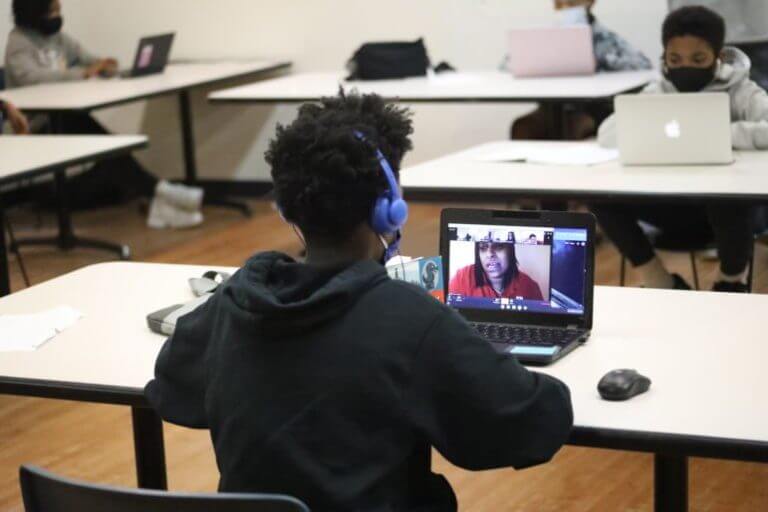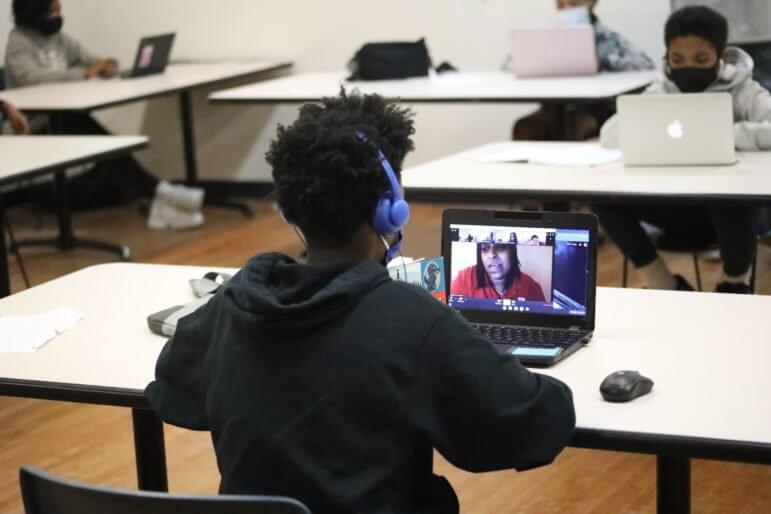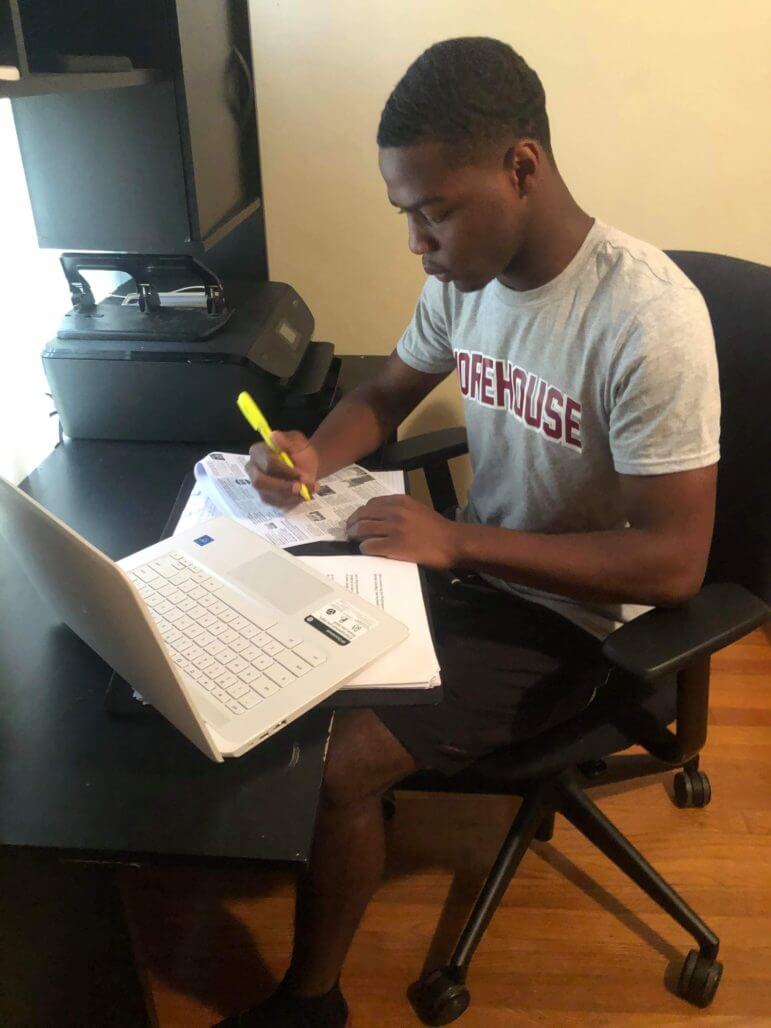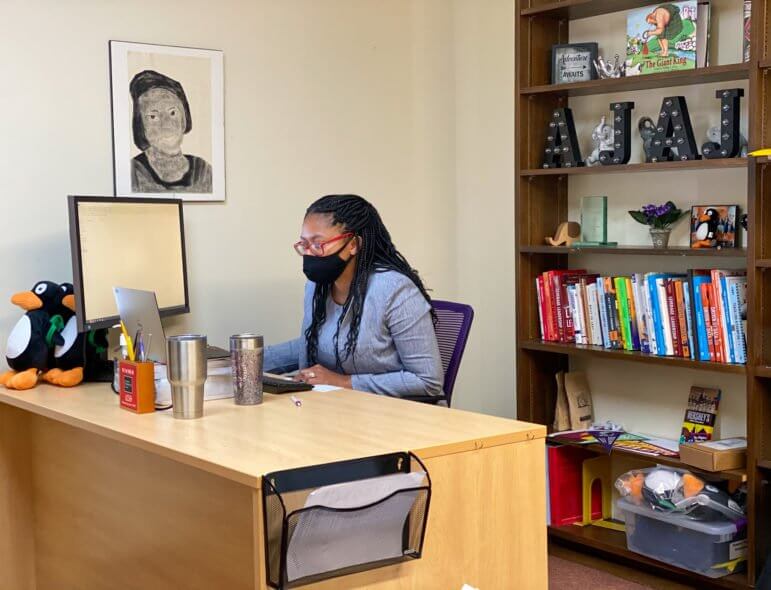

Anna Wolfe
A Jackson Public Schools student attends class on his laptop from a classroom at the Capitol Street campus of the Boys and Girls Club on Sept. 21, 2020. Normally an afterschool program, the Club began opening at 7 a.m. and facilitating distance learning for the children of working families after schools closed their doors due to the COVID-19 pandemic.
The new normal: How Mississippi students are adjusting to a virtual school year
By Aallyah Wright | Oct. 14, 2020
CLARKSDALE — On an early August morning, Clarksdale Collegiate Public Charter School teacher Hannah Fisher looked directly into her computer camera and asked her first graders to hold up their pencils. Every student who raised their pencil finished their assignment: spelling two and four letter words.
In a normal setting, Fisher would be in her classroom teaching students. Now, as a global pandemic has upended schooling and the way people teach, she’s fixated on students in small squares on Zoom. Some students were visible on their screens. A few others only displayed their names.
A few minutes later, Fisher reminded students to move on to write their words. In the midst of that, she stopped to address a student’s behavior.
“Sit up,” she said to the student. “Remember we’re not (lying) on the carpet. We’re writing right now. …I’m going to turn off your video and it’ll come on in 30 seconds. OK? I’m gonna get you to fix it in that time.”
Fisher’s first graders are not alone in struggling to stay engaged, communicate and navigate online platforms. Additionally, connectivity and internet access is a hindrance to getting kids online. The Mississippi Department of Education is currently rolling out a plan to deliver nearly 400,000 devices to students. Districts are supposed to receive them no later than Nov. 20. The department said 12 districts are receiving their devices this week, though many are still waiting.
Students and parents say they fear the negative impact the delay will have on student learning.
READ MORE: Mississippi is getting devices to every child. That’s just the first step.
“(Schools) want to make sure that kids are safe, accounted for, (and) engaged in their learning,” said Brennan Parton, policy and advocacy director at Data Quality Campaign. “They’re really having to rethink and reimagine and get creative about how we do that during this unprecedented time … the stakes are higher.”
Nearly three months ago, the state department required local school districts to submit their reopening plans detailing how they will resume — whether virtual, in-person or a mixture of the two.
The Clarksdale Municipal School District settled on virtual learning for the first half of the semester. This changed when school officials learned many students did not have internet access or devices. So for the first two weeks of school, students received instructional packets. Currently, 21% of the student population uses instructional packets only and 57% is virtual only, according to data from the Clarksdale Municipal district.
Students said the instructional packets cause confusion and leave them unmotivated because they don’t provide the opportunity for teacher-student interaction the way a traditional classroom set up does.

Marchellos Scott, Jr.
Marchellos Scott, Jr., a Clarksdale High School senior, sits in his room completing one of his instructional packets for class.
“I’ve never taken human anatomy so I don’t know what I’m doing, meaning more than likely if I don’t find the answers online, I will fail doing the packets,” Marchellos Scott, Jr., a Clarksdale High School senior, said. “The teachers said they’re just holding on, doing what they’re being told and everything keeps changing so they are confused as well.”
Scott is enrolled in virtual only but is required to complete instructional packets for certain classes, he said. He said he thinks his grades will suffer because he is not learning as much.
For other students, online learning halts much needed support services.
Griffin Threatt, an eighth grader at Clinton Junior High School, said he missed the face-to-face interaction with his teachers. Griffin is on a hybrid schedule, but a traditional classroom environment keeps him “more focused while I’m learning,” he said.
His mother, Amanda Threatt, praised his growth over the past year, but worries he won’t be able to keep up. She added he hasn’t received as much support as a student with special needs.
“I went ahead and got him a math tutor because he’s in Algebra this year just to keep him on task,” she said. “(One of his teachers) said it’s really hard to help the kids with IEPs (Individualized Education Plans) because we really don’t have the support right now… He feels like he’s learning but not at the rate he’s used to.”
Some parents said virtual learning created opportunities to spend quality time they wouldn’t have otherwise.
Before the pandemic, Jackson native Brittany Watson Cain worked eight-hour days. She arrived at home around 10:00 p.m. every night, so she rarely saw her four children. When schools closed in March, so did the doors at her job. She started working from home.
“By the time you get home, you’re exhausted, they’re tired, so it wasn’t always the best scenario,” Watson Cain said. “It’s harder for some people because they don’t have that. They really don’t have childcare, you know? So I do understand.”
District officials said technology allows students to explore and use applications on their own even though it poses some challenges. Clarksdale Collegiate students had devices before the pandemic, but now students have devices at home. This means students don’t have in-person teacher support to assist with devices. Despite this, students are still able to navigate programs — like first graders submitting Google Forms, said Amanda Johnson, executive director of Clarksdale Collegiate.

Aallyah Wright, Mississippi Today
Amanda Johnson, executive director of Clarksdale Collegiate, checks the daily morning chat in her office.
“We’ve been pushed to think about how we use technology and just teaching our kids and getting them engaged,” Johnson said. “It’s allowing technology to help us solve problems and help us support our kids more. There’s no reason why that should go away.”
Parton, the Data Quality Campgain director, says state education agencies and lawmakers should be forward-thinking about understanding how the pandemic has disrupted students’ learning progress. This magnifies learning inequities even more for students who need more support and resources.
“Even as they’re trying to meet students’ acute needs — internet access, laptops, engagement in class — states also need to be planful about the kinds of things that they’re going to need to do not only now, but the rest of the school year,” Parton said. “There’s going to be a lot of academic slide for students – more than you normally lose over the course of the summer.”
Carey Wright, state superintendent of Mississippi public schools, encourages teachers to accelerate learning as a way to address learning loss, or academic slide. For example, if a student is in fifth grade, the teacher should teach fifth grade standards.
“Our standards are designed in a way that they build on each other and also spiral,” she told Mississippi Today. “If you keep drilling and killing on some of these skills, kids are never going to get it. Start with grade-level standards and accelerate their learning. That approach is one that has been validated by others in the field.”
Remote learning is a learning curve for educators and families, but consistent communication and proper resources can alleviate concerns and access barriers for students.
“Until everyone gets on the same page, it’s only going to get worse,” Scott, the Clarksdale student, said. “It’s definitely gonna be hard on students, but I think we should still put together plans in case something like this happens again.”
The post How Mississippi students are adjusting to a virtual school year appeared first on Mississippi Today.
- Lots happening in the Crooked Letter State… - December 17, 2025
- Auditor: Half of state education money should go toward raising teacher pay - December 17, 2025
- ‘Being creative represents a form of freedom’ for those behind bars - December 17, 2025